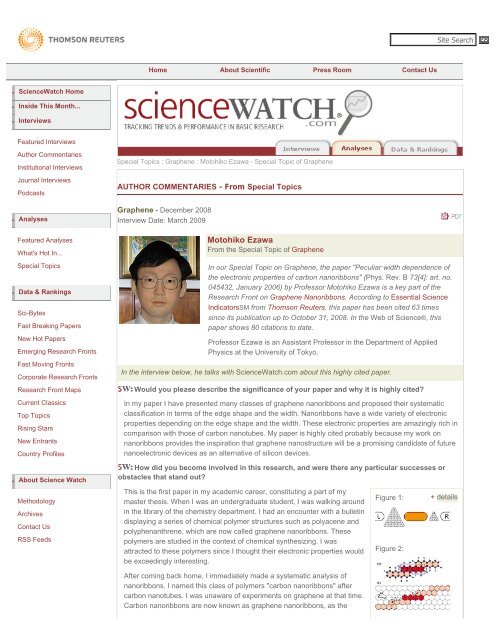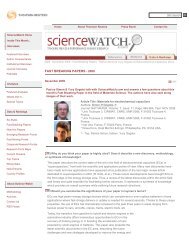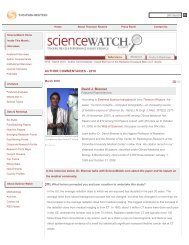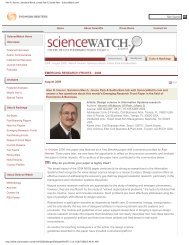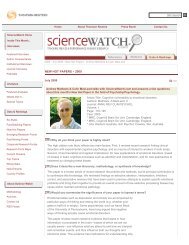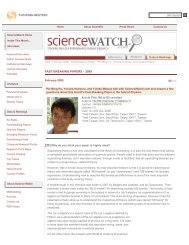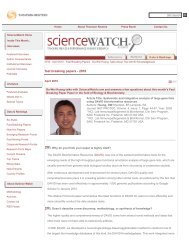Motohiko Ezawa - Special Topic of Graphene - ScienceWatch.com
Motohiko Ezawa - Special Topic of Graphene - ScienceWatch.com
Motohiko Ezawa - Special Topic of Graphene - ScienceWatch.com
You also want an ePaper? Increase the reach of your titles
YUMPU automatically turns print PDFs into web optimized ePapers that Google loves.
Home About Scientific Press Room Contact Us<br />
●<br />
●<br />
●<br />
<strong>ScienceWatch</strong> Home<br />
Inside This Month...<br />
Interviews<br />
Featured Interviews<br />
Author Commentaries<br />
Institutional Interviews<br />
Journal Interviews<br />
Podcasts<br />
<strong>Special</strong> <strong>Topic</strong>s : <strong>Graphene</strong> : <strong>Motohiko</strong> <strong>Ezawa</strong> - <strong>Special</strong> <strong>Topic</strong> <strong>of</strong> <strong>Graphene</strong><br />
AUTHOR COMMENTARIES - From <strong>Special</strong> <strong>Topic</strong>s<br />
●<br />
Analyses<br />
<strong>Graphene</strong> - December 2008<br />
Interview Date: March 2009<br />
●<br />
●<br />
Featured Analyses<br />
What's Hot In...<br />
<strong>Special</strong> <strong>Topic</strong>s<br />
Data & Rankings<br />
Sci-Bytes<br />
Fast Breaking Papers<br />
New Hot Papers<br />
Emerging Research Fronts<br />
Fast Moving Fronts<br />
Corporate Research Fronts<br />
Research Front Maps<br />
Current Classics<br />
Top <strong>Topic</strong>s<br />
Rising Stars<br />
New Entrants<br />
Country Pr<strong>of</strong>iles<br />
About Science Watch<br />
Methodology<br />
Archives<br />
Contact Us<br />
RSS Feeds<br />
<strong>Motohiko</strong> <strong>Ezawa</strong><br />
From the <strong>Special</strong> <strong>Topic</strong> <strong>of</strong> <strong>Graphene</strong><br />
In our <strong>Special</strong> <strong>Topic</strong> on <strong>Graphene</strong>, the paper "Peculiar width dependence <strong>of</strong><br />
the electronic properties <strong>of</strong> carbon nanoribbons" (Phys. Rev. B 73[4]: art. no.<br />
045432, January 2006) by Pr<strong>of</strong>essor <strong>Motohiko</strong> <strong>Ezawa</strong> is a key part <strong>of</strong> the<br />
Research Front on <strong>Graphene</strong> Nanoribbons. According to Essential Science<br />
IndicatorsSM from Thomson Reuters, this paper has been cited 63 times<br />
since its publication up to October 31, 2008. In the Web <strong>of</strong> Science®, this<br />
paper shows 80 citations to date.<br />
Pr<strong>of</strong>essor <strong>Ezawa</strong> is an Assistant Pr<strong>of</strong>essor in the Department <strong>of</strong> Applied<br />
Physics at the University <strong>of</strong> Tokyo.<br />
In the interview below, he talks with <strong>ScienceWatch</strong>.<strong>com</strong> about this highly cited paper.<br />
Would you please describe the significance <strong>of</strong> your paper and why it is highly cited?<br />
In my paper I have presented many classes <strong>of</strong> graphene nanoribbons and proposed their systematic<br />
classification in terms <strong>of</strong> the edge shape and the width. Nanoribbons have a wide variety <strong>of</strong> electronic<br />
properties depending on the edge shape and the width. These electronic properties are amazingly rich in<br />
<strong>com</strong>parison with those <strong>of</strong> carbon nanotubes. My paper is highly cited probably because my work on<br />
nanoribbons provides the inspiration that graphene nanostructure will be a promising candidate <strong>of</strong> future<br />
nanoelectronic devices as an alternative <strong>of</strong> silicon devices.<br />
How did you be<strong>com</strong>e involved in this research, and were there any particular successes or<br />
obstacles that stand out?<br />
This is the first paper in my academic career, constituting a part <strong>of</strong> my<br />
master thesis. When I was an undergraduate student, I was walking around<br />
in the library <strong>of</strong> the chemistry department. I had an encounter with a bulletin<br />
displaying a series <strong>of</strong> chemical polymer structures such as polyacene and<br />
polyphenanthrene, which are now called graphene nanoribbons. These<br />
polymers are studied in the context <strong>of</strong> chemical synthesizing. I was<br />
attracted to these polymers since I thought their electronic properties would<br />
be exceedingly interesting.<br />
After <strong>com</strong>ing back home, I immediately made a systematic analysis <strong>of</strong><br />
nanoribbons. I named this class <strong>of</strong> polymers "carbon nanoribbons" after<br />
carbon nanotubes. I was unaware <strong>of</strong> experiments on graphene at that time.<br />
Carbon nanoribbons are now known as graphene nanoribbons, as the<br />
Figure 1:<br />
Figure 2:<br />
+ details
graphene physics is expanding dramatically.<br />
The main obstacle is that I had very great difficulties publishing this paper.<br />
It took 10 months for the paper to be published; in contrast, it took only two<br />
months for calculations. Furthermore, my paper was rejected by the first<br />
journal to which I submitted it.<br />
Figure 3:<br />
Where do you see your research and the broader field leading in<br />
the future?<br />
<strong>Graphene</strong> nanoribbon is one <strong>of</strong> the graphene nanostructure derivatives. It is a one-dimensional object.<br />
We may as well consider a zero-dimensional derivative, which is graphene nanodisk (<strong>Ezawa</strong> M, "Metallic<br />
graphene nanodisks: Electronic and magnetic properties", Phys. Rev. B 76: art. no. 245415, 2007).<br />
Nanoribbons will be used as quantum wires, while nanodisks will be used as quantum dots.<br />
Combinations <strong>of</strong> nanoribbons and nanodisks will form electronic circuits. In future, nanoelectronic<br />
devices will be made solely <strong>of</strong> graphene, where nanoribbons and nanodisks are basic <strong>com</strong>ponents.<br />
<strong>Graphene</strong>-based circuits will replace silicon-based circuits in future.<br />
What are the implications <strong>of</strong> your work for this field?<br />
First, my work has revealed that the electronic properties are very sensitive to the edge shape and the<br />
width. This leads to a rich variety in the electronic properties <strong>of</strong> nanoribbons. Second, the theoretical<br />
treatment is relatively easy. Simple tight-binding calculations have been proven to be very successful in<br />
contrast to the study <strong>of</strong> the transition metals. This makes it possible to carry out a systematic analysis <strong>of</strong><br />
many classes <strong>of</strong> nanoribbons rather easily. Third, my work suggests applications <strong>of</strong> nanoribbon to future<br />
nanoelectronic devices. I have suggested that the <strong>com</strong>binations <strong>of</strong> nanoribbons will lead to further<br />
interesting physics.<br />
<strong>Motohiko</strong> <strong>Ezawa</strong><br />
Department <strong>of</strong> Applied Physics<br />
University <strong>of</strong> Tokyo<br />
Tokyo, Japan<br />
<strong>Motohiko</strong> <strong>Ezawa</strong>'s current most-cited paper in Essential Science Indicators, with 63 cites:<br />
<strong>Ezawa</strong> M, "Peculiar width dependence <strong>of</strong> the electronic properties <strong>of</strong> carbon nanoribbons," Phys.<br />
Rev. B 73(4): art. no. 045432, January 2006. Source: Essential Science Indicators from Thomson<br />
Reuters.<br />
KEYWORDS: GRAPHENE, CARBON NANORIBBONS, ELECTRONIC PROPERTIES, SHAPE, WIDTH,<br />
GRAPHENE NANOSTRUCTURE DERIVATIVES, GRAPHENE NANODISKS, NANOELECTRIC DEVICES.<br />
back to top<br />
<strong>Special</strong> <strong>Topic</strong>s : <strong>Graphene</strong> : <strong>Motohiko</strong> <strong>Ezawa</strong> - <strong>Special</strong> <strong>Topic</strong> <strong>of</strong> <strong>Graphene</strong><br />
Scientific Home | About Scientific | Site Search | Site Map<br />
Copyright Notices | Terms <strong>of</strong> Use | Privacy Statement


